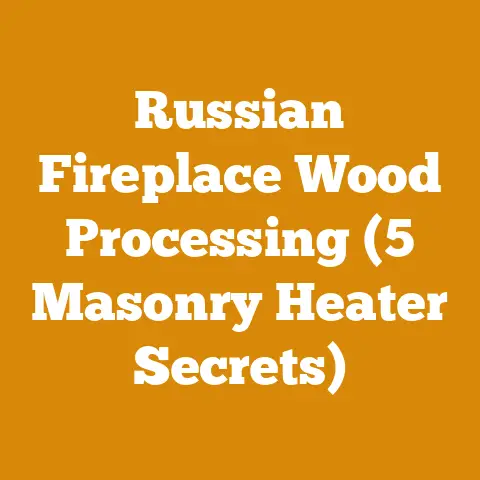What Is the Burning Temperature of Wood (5 Expert Insights)
Have you ever stood mesmerized before a crackling fire, feeling its warmth penetrate your very being? Have you ever wondered about the secret dance of heat and wood that creates that primal connection? I have. For years, I’ve been immersed in the world of wood – from felling towering trees to splitting logs under the relentless sun, and everything in between. And one question that always seems to surface, whether around a campfire or in a professional setting, is: “What is the burning temperature of wood?” It’s a seemingly simple question, but the answer is far more nuanced and fascinating than you might think.
In this article, I’m not just going to give you a number. I’m going to take you on a journey through the science of wood combustion, share my own experiences, and provide you with five expert insights that will change the way you look at firewood forever. We’ll delve into the different stages of burning, the factors that influence temperature, and how understanding these principles can help you achieve a hotter, cleaner, and more efficient burn. So, grab a seat, stoke the fire, and let’s get started.
Understanding the Burning Temperature of Wood: 5 Expert Insights
1. The Combustion Cascade: A Three-Stage Fire
Forget the image of simply lighting a match and instantly having flames. Burning wood is a complex process, a carefully choreographed dance of heat and volatile compounds that unfolds in three distinct stages. Understanding these stages is crucial to understanding the burning temperature of wood.
-
Stage 1: Drying (Up to 212°F / 100°C): This is where the magic begins, but not in the fiery way you might expect. Initially, the heat from your kindling or starter fire begins to evaporate the moisture within the wood. This is why seasoned wood burns so much better – it has significantly less water content to begin with. Think of it like trying to bake a cake with a soggy batter; it just won’t work. I’ve seen countless beginners struggle to get a fire going, only to realize they were using wood that was still dripping wet.
- Personal Story: I remember one particularly damp autumn, a friend and I were preparing firewood for a winter cabin trip. We were behind schedule, and the wood we had was far from seasoned. We stubbornly tried to force a fire, using excessive amounts of kindling and even a bit of accelerant. The result? A smoky, sputtering mess that barely produced any heat. It was a harsh lesson in the importance of properly dried wood.
-
Stage 2: Pyrolysis (212°F – 750°F / 100°C – 400°C): Now, the real fun begins. As the wood heats up further, it undergoes pyrolysis – a chemical breakdown caused by heat. This process releases volatile gases like methane, carbon monoxide, and hydrogen. These gases are what actually ignite and produce the flames we see. The remaining solid material is mostly carbon, which we know as charcoal.
-
Insight: The composition of these gases, and therefore the characteristics of the flames, varies depending on the type of wood. Hardwoods, like oak and maple, generally release more energy-rich gases, resulting in a hotter and longer-lasting burn compared to softwoods like pine.
-
Stage 3: Combustion (750°F+ / 400°C+): This is the final act, where the volatile gases and the remaining charcoal react with oxygen, producing heat, light, and ash. The temperature in this stage can soar to well over 1100°F (600°C), depending on the wood species, moisture content, and air supply. A well-established fire in this stage will burn cleanly and efficiently, leaving behind minimal smoke.
-
Data Point: A study published in the Journal of Wood Science found that the combustion temperature of seasoned oak can reach up to 1300°F (700°C) under optimal conditions, while the combustion temperature of green pine may struggle to exceed 900°F (480°C).
2. Moisture: The Fire’s Nemesis
Moisture content is arguably the single most critical factor influencing the burning temperature of wood. Wet wood is like a sponge soaking up all the potential heat. The fire has to expend energy to evaporate the water before it can even begin to burn the wood itself. This not only lowers the overall temperature but also creates a smoky, inefficient burn.
- The Ideal Moisture Content: For optimal burning, firewood should have a moisture content of 20% or less. This means the wood has been properly seasoned, typically by air-drying for at least six months, or even longer for denser hardwoods.
-
How to Measure Moisture Content: Invest in a wood moisture meter. These handy devices are relatively inexpensive and provide an accurate reading of the moisture content within the wood. Simply insert the probes into a freshly split piece of wood, and the meter will display the percentage of moisture.
- Actionable Tip: Don’t just test the surface of the wood. Split a log and test the moisture content of the freshly exposed inner wood for a more accurate reading.
-
The Consequences of Wet Wood: Burning wet wood leads to several problems:
-
Lower Heat Output: As mentioned earlier, the fire has to expend energy evaporating water, reducing the amount of heat available for heating your home or cooking your food.
- Increased Smoke Production: Incomplete combustion of the volatile gases results in excessive smoke, which is not only unpleasant but also harmful to your health and the environment.
-
Creosote Buildup: The unburned gases condense in your chimney or stovepipe, forming creosote, a highly flammable substance that can lead to dangerous chimney fires.
-
Personal Story: Years ago, I helped a friend clean out his chimney after a winter of burning poorly seasoned wood. The amount of creosote was alarming – thick, black, and incredibly difficult to remove. It was a stark reminder of the importance of using dry wood.
-
Expert Quote: “Seasoned firewood burns hotter, cleaner, and more efficiently. It’s a win-win for your wallet, your health, and the environment,” says John Gulland, a certified wood stove installer and chimney sweep.
3. Wood Species: The Hardwood vs. The density and composition of different wood species significantly impact their burning characteristics.
-
Hardwoods vs. Softwoods: Generally, hardwoods (deciduous trees like oak, maple, ash, and birch) are denser than softwoods (coniferous trees like pine, fir, and spruce). This means they contain more energy per unit volume and will burn hotter and longer. Softwoods, on the other hand, tend to ignite more easily and burn quickly, making them ideal for kindling.
- Data Point: Oak, with a density of around 45 lbs/cubic foot, has a higher BTU (British Thermal Unit) rating than pine, which has a density of around 25 lbs/cubic foot. BTU is a measure of the heat content of fuel.
-
The BTU Factor: BTU (British Thermal Unit) is a common unit of measurement for heat energy. The higher the BTU rating of a wood species, the more heat it will produce when burned.
-
Example: Oak has a BTU rating of approximately 28 million BTUs per cord, while pine has a BTU rating of approximately 20 million BTUs per cord.
-
Specific Wood Species and Their Burning Temperatures:
-
Oak: Known for its high density and long-lasting burn. Can reach temperatures of 1200-1300°F (650-700°C).
- Maple: Another excellent hardwood with a high BTU rating. Burns cleanly and produces a steady heat. Temperatures can reach 1100-1200°F (600-650°C).
- Ash: Easy to split and burns well, even when slightly green. Can reach temperatures of 1000-1100°F (540-600°C).
- Birch: Burns quickly and produces a bright flame. Good for starting fires but not ideal for long-lasting heat. Temperatures can reach 900-1000°F (480-540°C).
-
Pine: Ignites easily and burns quickly, making it a good choice for kindling. However, it produces more smoke and creosote than hardwoods. Temperatures typically range from 800-900°F (430-480°C).
-
Personal Story: I once tried to heat my entire home for a winter using only pine. It was a constant battle to keep the fire going, and I ended up using far more wood than I would have with hardwoods. The chimney also required more frequent cleaning due to the increased creosote buildup.
- Mixing and Matching: The best approach is often to mix hardwoods and softwoods. Use softwoods to get the fire started quickly, and then add hardwoods for sustained heat.
4. Air Supply: Feeding the Flames
Hardwoods vs. Softwoods: Generally, hardwoods (deciduous trees like oak, maple, ash, and birch) are denser than softwoods (coniferous trees like pine, fir, and spruce). This means they contain more energy per unit volume and will burn hotter and longer. Softwoods, on the other hand, tend to ignite more easily and burn quickly, making them ideal for kindling.
- Data Point: Oak, with a density of around 45 lbs/cubic foot, has a higher BTU (British Thermal Unit) rating than pine, which has a density of around 25 lbs/cubic foot. BTU is a measure of the heat content of fuel.
-
The BTU Factor: BTU (British Thermal Unit) is a common unit of measurement for heat energy. The higher the BTU rating of a wood species, the more heat it will produce when burned.
-
Example: Oak has a BTU rating of approximately 28 million BTUs per cord, while pine has a BTU rating of approximately 20 million BTUs per cord.
-
Specific Wood Species and Their Burning Temperatures:
-
Oak: Known for its high density and long-lasting burn. Can reach temperatures of 1200-1300°F (650-700°C).
- Maple: Another excellent hardwood with a high BTU rating. Burns cleanly and produces a steady heat. Temperatures can reach 1100-1200°F (600-650°C).
- Ash: Easy to split and burns well, even when slightly green. Can reach temperatures of 1000-1100°F (540-600°C).
- Birch: Burns quickly and produces a bright flame. Good for starting fires but not ideal for long-lasting heat. Temperatures can reach 900-1000°F (480-540°C).
-
Pine: Ignites easily and burns quickly, making it a good choice for kindling. However, it produces more smoke and creosote than hardwoods. Temperatures typically range from 800-900°F (430-480°C).
-
Personal Story: I once tried to heat my entire home for a winter using only pine. It was a constant battle to keep the fire going, and I ended up using far more wood than I would have with hardwoods. The chimney also required more frequent cleaning due to the increased creosote buildup.
- Mixing and Matching: The best approach is often to mix hardwoods and softwoods. Use softwoods to get the fire started quickly, and then add hardwoods for sustained heat.
Oxygen is the lifeblood of any fire. Without an adequate supply of air, the wood will smolder and produce smoke, but it won’t reach its full burning potential. Controlling the air supply is crucial for achieving a hot, efficient burn.
- The Importance of Airflow: Proper airflow allows the volatile gases released during pyrolysis to mix with oxygen and ignite completely. This results in a hotter flame and less smoke.
-
Air Control Mechanisms: Most wood stoves and fireplaces have air control mechanisms that allow you to adjust the amount of air entering the firebox.
- Primary Air: This is the main source of air for combustion. Opening the primary air control will increase the intensity of the fire.
- Secondary Air: Some stoves have secondary air inlets that introduce air above the fire, promoting more complete combustion of the volatile gases.
-
Optimizing Airflow:
-
Starting a Fire: When starting a fire, open the air controls fully to provide plenty of oxygen for the kindling to ignite.
- Maintaining a Fire: Once the fire is established, you can gradually reduce the air supply to slow down the burn and conserve wood. However, avoid starving the fire of oxygen, as this will lead to increased smoke and creosote buildup.
-
Burning Down: When letting the fire burn down, gradually close the air controls to allow the embers to burn out slowly.
-
Actionable Tip: Experiment with different air control settings to find the optimal balance between heat output and burn time for your specific stove and wood species.
-
The Chimney Effect: A properly sized and functioning chimney is essential for creating adequate draft, which draws air into the firebox and carries smoke and exhaust gases away. A blocked or improperly sized chimney can restrict airflow and lead to a smoky, inefficient burn.
-
Insight: The height and diameter of your chimney directly impact its draft. A taller chimney generally creates a stronger draft.
5. Firewood Preparation: From Forest to Fireplace
The journey of firewood from forest to fireplace is a crucial process that directly impacts its burning temperature and efficiency. Proper harvesting, splitting, and stacking are essential for producing high-quality firewood.
-
Sustainable Harvesting: Start with responsible forestry practices. Choose wood from sustainably managed forests or salvage dead or fallen trees. Avoid cutting down healthy trees solely for firewood.
- Material Sourcing Strategies: Establish relationships with local landowners or logging companies to secure a reliable supply of firewood. Consider purchasing firewood in bulk to save money.
-
Splitting: Splitting wood increases its surface area, allowing it to dry faster and burn more efficiently. Split logs into manageable sizes that fit your stove or fireplace.
-
Tool Usage Efficiency: Invest in a good quality splitting axe or hydraulic log splitter. A sharp axe will make the job easier and safer.
- Personal Story: I used to struggle with a dull axe, spending hours wrestling with stubborn logs. Once I invested in a quality axe and learned how to sharpen it properly, the splitting process became significantly easier and more efficient.
-
Stacking: Proper stacking is essential for air-drying firewood. Stack the wood in a single row, with gaps between the logs to allow for airflow. Choose a sunny and windy location for optimal drying.
-
Workflow Optimization: Stacking wood on pallets or raised platforms will further improve airflow and prevent moisture from wicking up from the ground.
- Actionable Tip: Cover the top of the woodpile with a tarp to protect it from rain and snow, but leave the sides open to allow for ventilation.
-
Drying Time: The drying time for firewood varies depending on the wood species, climate, and stacking method. Generally, hardwoods require at least six months of air-drying, while softwoods may dry in as little as three months.
-
Data Point: A study by the University of Maine found that properly stacked firewood can lose up to 50% of its moisture content during a six-month drying period.
-
Storage: Once the firewood is properly seasoned, store it in a dry, sheltered location to prevent it from reabsorbing moisture.
-
Project Planning and Execution: Plan your firewood preparation schedule well in advance to ensure you have a sufficient supply of dry wood for the winter.
Common Challenges and Solutions
Even with the best planning and preparation, challenges can arise when dealing with firewood. Here are some common problems and their solutions:
-
Problem: Difficulty Starting Fires:
- Solution: Use plenty of dry kindling and tinder. Ensure adequate airflow to the firebox. Consider using a fire starter log or wax-based fire starter.
-
Problem: Smoky Fires:
-
Solution: Use properly seasoned wood. Ensure adequate airflow to the firebox. Clean your chimney regularly to remove creosote buildup.
-
Problem: Slow-Burning Fires:
-
Solution: Use denser hardwoods. Ensure adequate airflow to the firebox. Split logs into smaller pieces to increase surface area.
-
Problem: Excessive Creosote Buildup:
-
Solution: Use properly seasoned wood. Burn hotter fires. Clean your chimney regularly. Consider installing a catalytic combustor in your wood stove.
-
Problem: Wood Rotting:
-
Solution: Store firewood in a dry, sheltered location. Stack wood properly to promote airflow. Avoid storing wood directly on the ground.
Current Trends and Best Practices
The world of wood processing and firewood production is constantly evolving. Here are some current trends and best practices to keep in mind:
- Sustainable Forestry Practices: Increased emphasis on responsible forest management and harvesting techniques.
- Wood Pellet Stoves: Growing popularity of wood pellet stoves as a clean and efficient alternative to traditional wood stoves.
- Kiln Drying: Use of kiln drying to accelerate the seasoning process and produce firewood with consistently low moisture content.
- Automation: Increased use of automated log splitters and firewood processors to improve efficiency and reduce labor costs.
- Biochar Production: Utilizing wood waste to produce biochar, a valuable soil amendment and carbon sequestration tool.
Conclusion: Mastering the Art of Fire
Understanding the burning temperature of wood is more than just knowing a number. It’s about understanding the complex interplay of factors that influence combustion, from moisture content and wood species to airflow and firewood preparation. By applying the five expert insights I’ve shared in this article, you can achieve a hotter, cleaner, and more efficient burn, whether you’re heating your home, cooking outdoors, or simply enjoying the warmth of a crackling fire.
Key Takeaways:
- Moisture is the enemy: Always use properly seasoned wood with a moisture content of 20% or less.
- Hardwoods reign supreme: Hardwoods provide more heat and burn longer than softwoods.
- Airflow is essential: Ensure adequate airflow to the firebox for complete combustion.
- Preparation is key: Proper harvesting, splitting, and stacking are crucial for producing high-quality firewood.
- Stay informed: Keep up with current trends and best practices in wood processing and firewood production.
Next Steps:
- Invest in a wood moisture meter and start testing your firewood.
- Learn to identify different wood species and their burning characteristics.
- Experiment with different air control settings on your stove or fireplace.
- Improve your firewood preparation techniques.
- Consider attending a workshop or seminar on wood processing and firewood production.
The world of wood and fire is a fascinating one, full of challenges and rewards. By embracing these insights and continuing to learn, you can become a true master of the art of fire. Now, go forth, prepare your wood, and enjoy the warmth and beauty of a well-tended flame.






